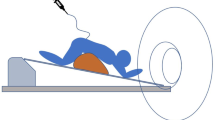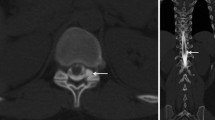Abstract
In contrast-enhanced (CE) MR myelography, hyperintense signal outside the intrathecal space in T1-weighted sequences with spectral presaturation inversion recovery (SPIR) is usually considered to be due to CSF leakage. We retrospectively investigated a hyperintense signal at the apex of the lung appearing in this sequence in patients with SIH (n = 5), CSF rhinorrhoea (n = 2), lumbar spine surgery (n = 1) and in control subjects (n = 6). Intrathecal application of contrast agent was performed in all patients before MR examination, but not in the control group. The reproducible signal increase was investigated with other fat suppression techniques and MR spectroscopy. All patients and controls showed strongly hyperintense signal at the apex of the lungs imitating CSF leakage into paraspinal tissue. This signal increase was identified as an artefact, caused by spectroscopically proven shift and broadening of water and lipid resonances (1–2 ppm) in this anatomical region. Only patients with SIH showed additional focal enhancement along the spinal nerve roots and/or in the spinal epidural space. In conclusion CE MR myelography with spectral selective fat suppression shows a reproducible cervicothoracic artefact, imitating CSF leakage. Selective water excitation technique as well as periradicular and epidural contrast collections may be helpful to discriminate between real pathological findings and artefacts.





Similar content being viewed by others
References
Schaltenbrand G (1938) Neuere Anschauungen zur Pathophysiologie der Liquorzirkulation. Zentralblatt für Neurochirurgie 5:290–300
Schaltenbrand G (1953) Normal and pathological physiology of the cerebrospinal fluid circulation. Lancet 1:805–808
Schievink WI (2006) Spontaneous spinal cerebrospinal fluid leaks and intracranial hypotension. JAMA 295:2286–2966
Rando TA, Fishman RA (1992) Spontaneous intracranial hypotension: report of two cases and review of the literature. Neurology 42:481–487
Mokri B, Krueger BR, Miller GM et al (1991) Meningeal gadolinium enhancement in low-pressure headaches. Ann Neurol 30:294–295
Schievink WI, Meyer FB, Atkinson JLD et al (1996) Spontaneous spinal cerebrospinal fluid leaks and intracranial hypotension. J Neurosurg 84:598–605
Albayram S, Kilic F, Ozer H et al (2008) Gadolinium-enhanced MR cisternography to evaluate dural leaks in intracranial hypotension syndrome. AJNR Am J Neuroradiol 29:116–121
Tali ET, Ercan N, Krumina G et al (2002) Intrathecal gadolinium (gadopentetate dimeglumine) enhanced magnetic resonance myelography and cisternography: results of a multicenter study. Invest Radiol 37:152–159
Kraemer N, Berlis A, Schumacher M (2005) Intrathecal gadolinium-enhanced MR myelography showing multiple dural leakages in a patient with Marfan syndrome. AJR Am J Roentgenol 185:92–94
Schievink WI, Maya MM, Louy C et al (2008) Diagnostic criteria for spontaneous spinal CSF leaks and intracranial hypotension. AJNR Am J Neuroradiol 29:853–856
Siebner HR, Grafin von Einsiedel H, Conrad B (1997) Magnetic resonance ventriculography with gadolinium DTPA: report of two cases. Neuroradiology 39:418–422
Zeng Q, Xiong L, Jinkins JR et al (1999) Intrathecal gadolinium-enhanced MR myelography and cisternography: a pilot study in human patients. AJR Am J Roentgenol 173:1109–1115
Wenzel R, Leppien A (2000) Gadolinium-myelocisternography for cerebrospinal fluid rhinorrhoea. Neuroradiology 42:874–880
Jinkins JR, Rudwan M, Krumina G et al (2002) Intrathecal gadolinium-enhanced MR cisternography in the evaluation of clinically suspected cerebrospinal fluid rhinorrhea in humans: early experience. Radiology 222:555–559
Reiche W, Komenda Y, Schick B et al (2002) MR cisternography after intrathecal Gd-DTPA application. Eur Radiol 12:2943–2949
Aydin K, Guven K, Sencer S et al (2004) MRI cisternography with gadolinium-containing contrast medium: its role, advantages and limitations in the investigation of rhinorrhoea. Neuroradiology 46:75–80
Tomoda Y, Korogi Y, Aoki T et al (2008) Detection of cerebrospinal fluid leakage: initial experience with three-dimensional fast spin-echo magnetic resonance myelography. Acta Radiol 49:197–203
Ray DE, Cavanagh JB, Nolan CC et al (1996) Neurotoxic effects of gadopentetate dimeglumine: behavioral disturbance and morphology after intracerebroventricular injection in rats. AJNR Am J Neuroradiol 17:365–373
Skalpe IO (1998) Is it dangerous to inject MR contrast media into the subarachnoid space? Acta Radiol 39:100
Anzai Y, Lufkin RB, Jabour BA et al (1992) Fat-suppression failure artifacts simulating pathology on frequency-selective fat-suppression MR images of the head and neck. AJNR Am J Neuroradiol 13:879–884
Borges AR, Lufkin RB, Huang AY et al (1997) Frequency-selective fat suppression MR imaging. Localized asymmetric failure of fat suppression mimicking orbital disease. J Neuroophthalmol 17:12–17
Delfaut EM, Beltran J, Johnson G et al (1999) Fat suppression in MR imaging: techniques and pitfalls. Radiographics 19:373–382
Yoshimitsu K, Varma DG, Jackson EF (1995) Unsuppressed fat in the right anterior diaphragmatic region on fat-suppressed T2-weighted fast spin-echo MR images. J Magn Reson Imaging 5:145–149
Mürtz P, Krautmacher C, Träber F et al (2007) Diffusion-weighted whole-body MR imaging with background body signal suppression: a feasibility study at 3.0 Tesla. Eur Radiol 17:3031–3037
Krinsky G, Rofsky NM, Weinreb JC (1996) Nonspecificity of short inversion time inversion recovery (STIR) as a technique of fat suppression: pitfalls in image interpretation. AJR Am J Roentgenol 166:523–526
Meyer CH, Pauly JM, Macovski A, Nishimura DG (1990) Simultaneous spatial and spectral selective excitation. Magn Reson Med 15:287–304
Schick F, Forster J, Machann J, Huppert P et al (1997) Highly selective water and fat imaging applying multislice sequences without sensitivity to B1 field inhomogeneities. Magn Reson Med 38:269–274
Zur Y (2000) Design of improved spectral-spatial pulses for routine clinical use. Magn Reson Med 43:410–420
Niitsu M, Tohno E, Itai Y (2003) Fat suppression strategies in enhanced MR imaging of the breast: comparison of SPIR and water excitation sequences. J Magn Reson Imaging 18:310–314
Hauger O, Dumont E, Chateil JF et al (2002) Water excitation as an alternative to fat saturation in MR imaging: preliminary results in musculoskeletal imaging. Radiology 224:657–663
Zenker W, Bankoul S, Braun JS (1994) Morphological indications for considerable diffuse reabsorption of cerebrospinal fluid in spinal meninges particularly in the areas of meningeal funnels. An electronmicroscopical study including tracing experiments in rats. Anat Embryol (Berl) 189:243–258
Bozanovic-Sosic R, Mollanji R, Johnston MG (2001) Spinal and cranial contributions to total cerebrospinal fluid transport. Am J Physiol Regul Integr Comp Physiol 281:R909–R916
Author information
Authors and Affiliations
Corresponding author
Rights and permissions
About this article
Cite this article
Hattingen, E., DuMesnil, R., Pilatus, U. et al. Contrast-enhanced MR myelography in spontaneous intracranial hypotension: description of an artefact imitating CSF leakage. Eur Radiol 19, 1799–1808 (2009). https://doi.org/10.1007/s00330-009-1347-0
Received:
Revised:
Accepted:
Published:
Issue Date:
DOI: https://doi.org/10.1007/s00330-009-1347-0




